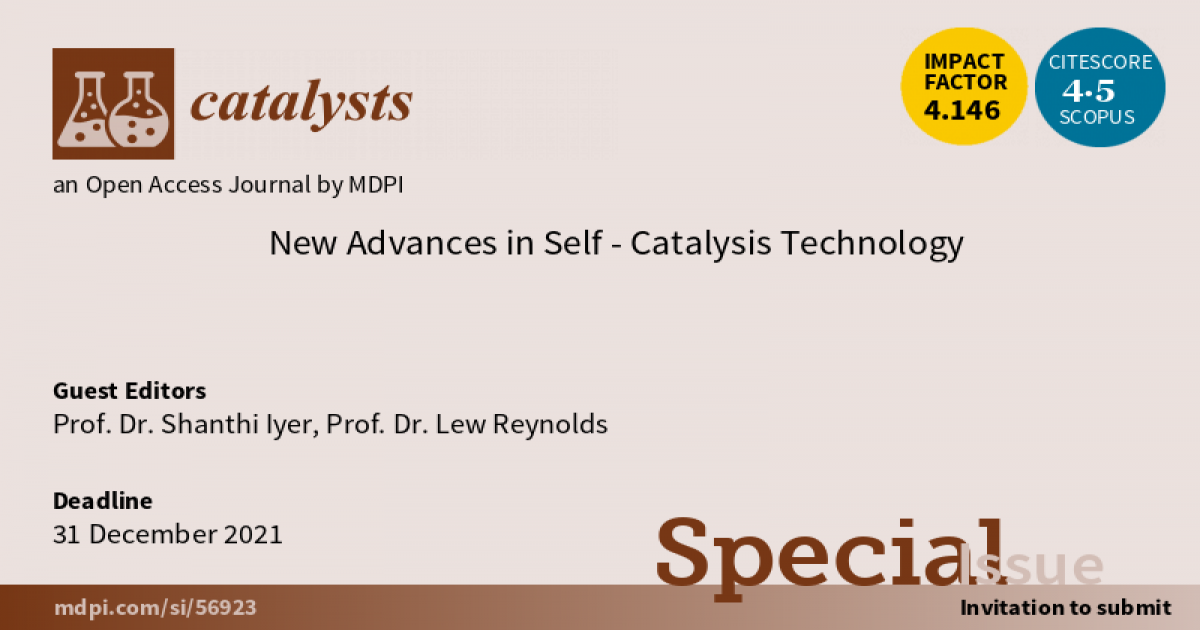- 4.0Impact Factor
- 7.6CiteScore
- 17 daysTime to First Decision
New Advances in Self-Catalysis Technology
This special issue belongs to the section “Catalytic Materials“.
Special Issue Information
Dear Colleagues,
Great strides have been made in nanowire (NW) synthesis and the manipulation of material and device properties at the nanoscale by exploiting quantum confinement, strain relaxation, high optical absorption, and design flexibility of nanoheterostructures that are exclusive to various NW configurations. Recent years have seen a systematic shift from the catalyzed growth of NWs to a self-catalyzed growth approach to alleviate the detrimental effects of the catalyst, impacting subsequent device performance. Integration of these NWs on a variety of substrates during either synthesis or post-growth transfer of nanowires with an ability to recycle substrates and less material consumption has made this an attractive, cost-effective approach. As a result, the application of semiconductor NWs has broadened to a large field of interest ranging from simple optoelectronic devices to photonic integrated circuits, and single photon detection in quantum information science to automotive LIDAR. In addition, their incorporation on flexible substrates serves as a characteristic which is potentially relevant to wearable textile and healthcare technologies. For these reasons, there has been an exponential increase in research publications.
This Special Issue therefore aims to capture one small segment of this exciting field and is focused on the most recent progress and advances in the field of semiconductor nanowires grown by self-catalyzed epitaxy with emphasis on growth, modeling, fabrication of nanoscale optoelectronic devices, and applications thereof.
Prof. Dr. Shanthi Iyer
Prof. Dr. Lew Reynolds
Guest Editors
Manuscript Submission Information
Manuscripts should be submitted online at www.mdpi.com by registering and logging in to this website. Once you are registered, click here to go to the submission form. Manuscripts can be submitted until the deadline. All submissions that pass pre-check are peer-reviewed. Accepted papers will be published continuously in the journal (as soon as accepted) and will be listed together on the special issue website. Research articles, review articles as well as short communications are invited. For planned papers, a title and short abstract (about 250 words) can be sent to the Editorial Office for assessment.
Submitted manuscripts should not have been published previously, nor be under consideration for publication elsewhere (except conference proceedings papers). All manuscripts are thoroughly refereed through a single-blind peer-review process. A guide for authors and other relevant information for submission of manuscripts is available on the Instructions for Authors page. Catalysts is an international peer-reviewed open access monthly journal published by MDPI.
Please visit the Instructions for Authors page before submitting a manuscript. The Article Processing Charge (APC) for publication in this open access journal is 2200 CHF (Swiss Francs). Submitted papers should be well formatted and use good English. Authors may use MDPI's English editing service prior to publication or during author revisions.
Keywords
- self-catalyzed semiconductor nanowires
- growth and modeling
- optoelectronic devices and applications
- nanostructures
- nanoscale devices

Benefits of Publishing in a Special Issue
- Ease of navigation: Grouping papers by topic helps scholars navigate broad scope journals more efficiently.
- Greater discoverability: Special Issues support the reach and impact of scientific research. Articles in Special Issues are more discoverable and cited more frequently.
- Expansion of research network: Special Issues facilitate connections among authors, fostering scientific collaborations.
- External promotion: Articles in Special Issues are often promoted through the journal's social media, increasing their visibility.
- e-Book format: Special Issues with more than 10 articles can be published as dedicated e-books, ensuring wide and rapid dissemination.

